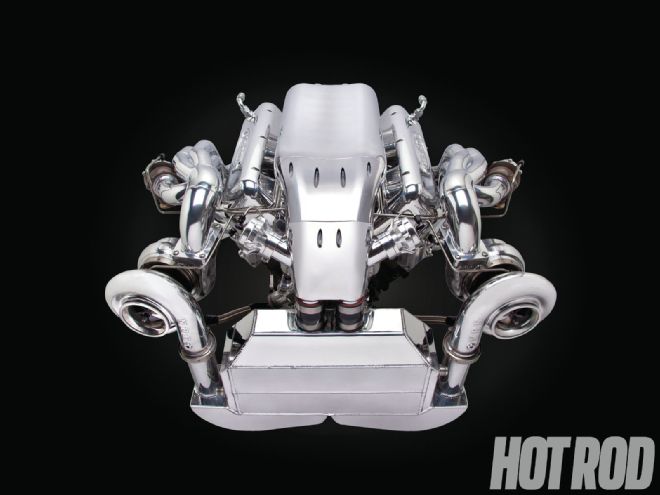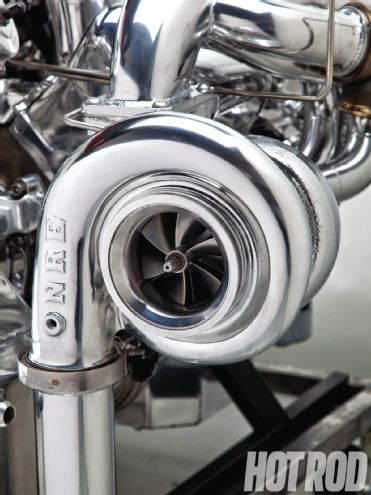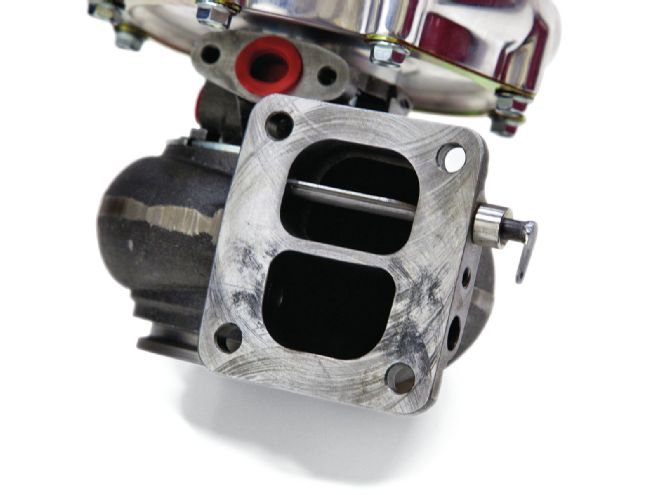
Pump-gas motors are all the rage these days. Frankly, the power output has climbed so far into the stratosphere that much of the monster torque being produced is unusable on the street. But too much power is just enough, in our book. Besides, there's always Drag Week™, which has become the ultimate proving ground for street-car dominance and engine performance and durability--and where turbo motors tend to leave nitrous and supercharged engines in the dust. We've preached the virtues of turbos for years, but the packaging has always been complex and expensive, the sort of installation that most hot rodders can't complete at home. Nelson Racing Engines aims to change at least some of that.
 Here's the reversed turbo, its housing scrolling the opposite direction of nearly all other turbochargers. To do this, custom turbine and compressor wheels are required. The benefit is a huge simplification of the hot and cold plumbing.
Here's the reversed turbo, its housing scrolling the opposite direction of nearly all other turbochargers. To do this, custom turbine and compressor wheels are required. The benefit is a huge simplification of the hot and cold plumbing.
NRE has not gone quietly about the business of building and marketing its turbo crate engine packages. Tom Nelson flaunts the power given to his street-car clientele on his YouTube channel (Youtube.com/user/NelsonRacingEngines), with celebratory burnouts and dyno vids. What you see here is 1,600 hp of pump-gas, twin-turbo Nelson awesomeness in perhaps the cleanest package ever assembled. The 632ci big-block Chevy is called the Hot Rod Series, and it costs $52,000. It's beyond spendy, but if 1,600 ponies don't make it a good deal, then simply crank up the boost, change the calibration, and it'll pump out 2,200 hp on VP C-16 race fuel--and look amazing while doing it. The key to its good looks are NRE's patented Mirror Image Turbos and Alien intake manifold.
The turbos are unique because the billet housings come with standard rotating guts or counter-rotating guts and a reversed housing. This allows the builder to plumb them symmetrically, which simplifies intercooler, charge-tubing, and exhaust plumbing. It also allows the use of a single header design instead of the separate designs required when mounting two turbos that spin in the same direction. Both left- and righthand NRE turbos have billet compressor wheels, Inconel exhaust wheels, and shortened air-inlet flanges, which saves space between the front of the turbo and the radiator, which means there's room for high-flow, 5-inch diameter plumbing. The inlet, outlet, and exhaust flanges are also grooved for sturdy V-band clamps to keep the plumbing intact at high boost. A 4-inch or 5-inch exhaust V-band flange can also be spec'd for an unrestricted exhaust system. And for those data-hungry hot rodders, compressor-wheel speed sensors are built into the turbos. Nelson's 72mm T4 turbos are available for $3,800 each, and 88mm T6 turbos cost $7,000.
 A diaphragm-actuated, electronically controlled valve built into the A/R section of the turbo controls how quickly it spools up and builds boost. It shuts off half of the port for faster spool times, and the spool rate can be tailored to aid traction during the holeshot.
A diaphragm-actuated, electronically controlled valve built into the A/R section of the turbo controls how quickly it spools up and builds boost. It shuts off half of the port for faster spool times, and the spool rate can be tailored to aid traction during the holeshot.
The other star of Nelson's show is the $8,000 polished- aluminum Alien intake manifold. Looks aside, it provides enough airflow to support 2,500 hp, and the fuel system is stealthily hidden inside. Fuel supply and return plumbing are routed directly to the rear of the intake, and twin pressure regulators are built in. A pair of injectors is staggered on the valley side of each runner. A throttle position sensor is also built in, and the throttle linkage is hidden in the bottom of the throttle-body. It's one of the most well thought out designs we've seen yet.
What does it take to make this kind of power and survive? Boost, obviously, and the 2,200hp dyno pull was made with more than 30 psi. The 1,600hp, pump-gas setting required just 16 psi. At 22 psi, the engine makes 1,866 hp, and at 27 psi Nelson's DTS dyno reports 1,917 hp. The horsepower peaks at less than 6,000 rpm and peak torque occurs at 5,100 rpm. By the way, we watched it make 1,752 lb-ft on a dyno pull, and Nelson says this package is good for 2,100 lb-ft with the wick turned way up. The survival part comes from a strong rotating assembly. That means a Dart Big M tall deck block with 4.600 bores, a Callies Magnum 4.75-inch-stroke forged crankshaft, and JE custom NRE-spec forged pistons. Nelson uses a solid roller cam with Crower lifters, Smith Bros. chrome-moly pushrods, a Dyna Gear billet roller timing set with a Torrington bearing, T&D shaft rockers, stainless-steel intake valves, and Inconel exhaust valves. The cylinder heads are Brodix Head Hunter 383s, and Nelson always uses Electromotive's crank trigger ignition and Tec 3R engine management system.